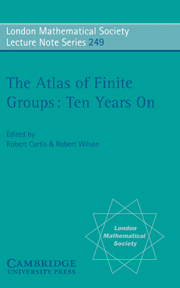Book contents
- Frontmatter
- Contents
- Introduction
- Addresses of registered participants
- Addresses of non-participating authors
- Programme of lectures
- Conference photograph and key
- Symmetric presentations and orthogonal groups
- A constructive recognition algorithm for the special linear group
- Relations in M666
- A survey of symmetric generation of sporadic simple groups
- Harish-Chandra theory, q-Schur algebras, and decomposition matrices for finite classical groups
- The Meataxe as a tool in computational group theory
- Branching rules for modular projective representations of the symmetric groups
- Characters and surfaces: a survey
- On the characterization of finite groups by characters
- Finite linear groups of small degree
- Minimal parabolic systems for the symmetric and alternating groups
- Probabilistic methods in the generation of finite simple groups
- Condensing tensor product modules
- Intersections of Sylow subgroups in finite groups
- Anatomy of the Monster: I
- An integral ‘Meat-axe’
- Finite rational matrix groups: a survey
- Chamber graphs of sporadic group geometries
- An Atlas of sporadic group representations
- Presentations of reductive Fischer groups
- A brief history of the ATLAS
On the characterization of finite groups by characters
Published online by Cambridge University Press: 19 May 2010
- Frontmatter
- Contents
- Introduction
- Addresses of registered participants
- Addresses of non-participating authors
- Programme of lectures
- Conference photograph and key
- Symmetric presentations and orthogonal groups
- A constructive recognition algorithm for the special linear group
- Relations in M666
- A survey of symmetric generation of sporadic simple groups
- Harish-Chandra theory, q-Schur algebras, and decomposition matrices for finite classical groups
- The Meataxe as a tool in computational group theory
- Branching rules for modular projective representations of the symmetric groups
- Characters and surfaces: a survey
- On the characterization of finite groups by characters
- Finite linear groups of small degree
- Minimal parabolic systems for the symmetric and alternating groups
- Probabilistic methods in the generation of finite simple groups
- Condensing tensor product modules
- Intersections of Sylow subgroups in finite groups
- Anatomy of the Monster: I
- An integral ‘Meat-axe’
- Finite rational matrix groups: a survey
- Chamber graphs of sporadic group geometries
- An Atlas of sporadic group representations
- Presentations of reductive Fischer groups
- A brief history of the ATLAS
Summary
Abstract
The first object is a survey on the isomorphism problem of integral group rings and the Zassenhaus conjectures related to this question. Then it is shown how automorphisms of character tables may be used to get information about automorphisms of integral group rings. This permits the proof of one of the Zassenhaus conjectures for series of simple or almost simple groups. Finally a short proof is given that {1, 2, 3}-characters determine a finite group up to isomorphism.
Introduction
R. Brauer in his famous lectures in 1963 on representations of finite groups posed more than 40 problems which have had a big influence on this topic since then [7]. Many of these problems concern the question of which properties of a finite group G are reflected by its character table. The basic problem is to determine what kind of information about G additional to its character table is needed in order to determine G up to isomorphism. We shall consider two aspects of these questions.
The first one is the isomorphism problem of integral group rings of finite groups. This is an old and still open problem. It was considered for the first time in G. Higman's thesis in 1939 [38, p. 100]. The question is whether ℤG ≅ ℤH implies that G ≅ H. It is a result of G. Glauberman that finite groups G and H with isomorphic integral group rings ℤG and ℤH have the same character table [16, (3.17)]. Thus the isomorphism problem fits well into the context of Brauer's problems. Note that K. W. Roggenkamp and A. Zimmermann recently constructed two non-isomorphic infinite polycyclic groups G and H whose integral group rings are Morita equivalent.
- Type
- Chapter
- Information
- The Atlas of Finite Groups - Ten Years On , pp. 119 - 138Publisher: Cambridge University PressPrint publication year: 1998
- 2
- Cited by

